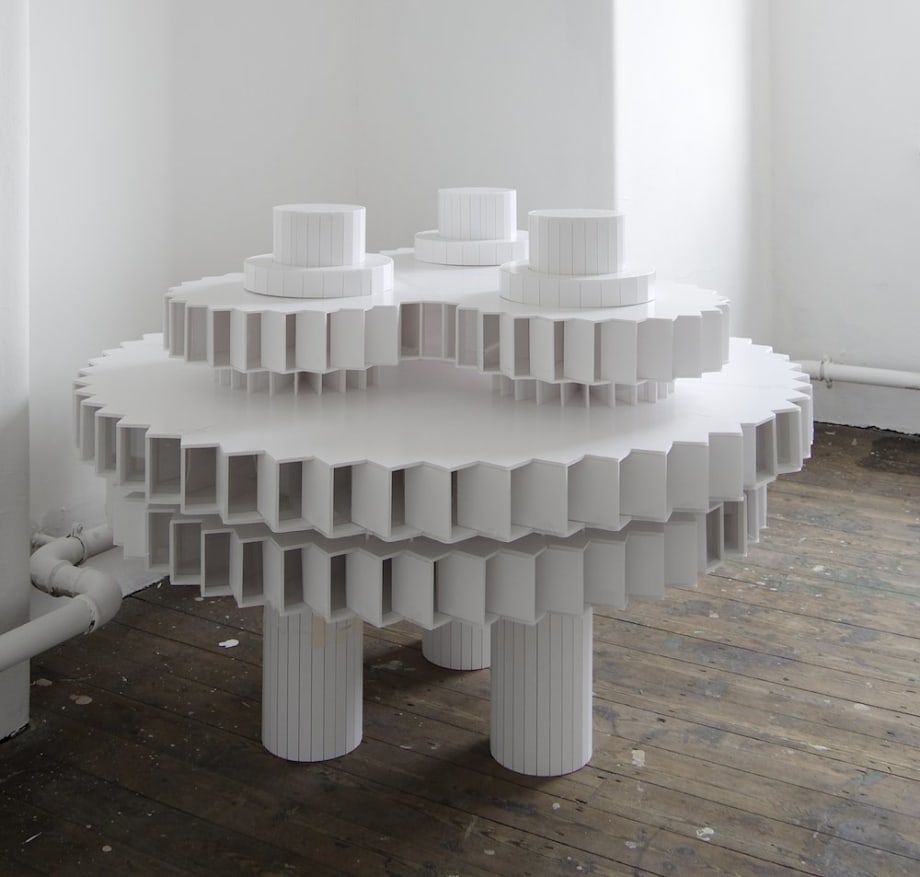Campbell’s new work focuses on the world portrayed and proposed by the proliferation of ubiquitous upmarket
lifestyle and travel guides. Marketed as “a precise, informative, insider’s checklist of all you need to know about the
world’s most intoxicating cities” Campbell’s work is caught between a guarded sense of dismay over such style over
substance and a genuine desire to embrace the experience offered.
Image rich and with a carefully selected colour palette these publications are intelligently illustrated, employing cool
architectural photography with tautly corrected perspective and no lens distortion these images key into our
knowledge both of art (via Edward Hopper and Bernd and Hilla Becher) and of cinema. These guides serve as golden
ticket enabling us to project our lives into places that we will probably never visit, with the secondary function that
they look good on our bookshelves advertising our cosmopolitan worldliness in a compact row of pantone neatness.
In Hotel Series Campbell carefully collages tiny circles cut directly from images depicting hotel interiors from different
cities. Each dot is placed on white paper in the same layout as the original photograph and in each case Campbell
has only selected one blue, one yellow, two browns, and a black, creating an new reading of the photos through her
ambiguously seductive minimal constellations that reflect on the banal nature of international interior design.
In stark contrast to these delicate collages Campbell has created a series of dramatically enlarged found images UV
printed onto powder coated aluminium entitled For I have known them all already, known them all # 1-6. Each image,
selected from a travel guide, has then been almost entirely removed to leave an aperture surrounded by a border of
abstract colour and shape that relates more to the history of abstract painting than to the photographic source.
This relentless interrogation of such a specific source and subject matter is continued in an untitled series of works
that again sit deliberately between contemporary art’s disciplines and conventions. Photographic images are again
printed onto aluminium however this time Campbell has aggressively obliterated each image entirely with spray paint
limiting our engagement with the photograph by rendering it as subtle ghost image only just visible through the
painted surface.
Cath Campbell’s practice to date is dominated by an ongoing enquiry into the status, meaning and fabric of
architecture and public space. Taking Modernism as a point of departure Campbell has consistently re-appropriated
architectural imagery to create works that reinvent our associations with the built environment. And we said nothing,
all the day continues this analysis from the privacy of her dining room table. The work is an ongoing unlimited series
of photographs that are presented stacked and leant along a narrow shelf. Taking it’s title from a line in John Donne’s
poem The Ecstasy each photograph is of another photograph chosen as if Campbell is a tourist looking around the
city portrayed, taking snaps of things that catch her eye. These Lo-Fi images, which often include the reflection of
Campbell and her Camera, serve to undermine the status assumed by the original imagery.
Alongside these photographic works, Campbell presents a number of new sculptures continuing her interest in recreating
found architecture as scale models. Information gleaned from anonymous Google images is used to piece
together three-dimensional form from two dimensional images, allowing an element of editing, adding and deleting to
create an object that acts as a credible architectural form.
Ideal Mexico, a chance but fitting title taken from the model name of the old central heating boilers in the gallery
building, invites us to question the relationship between reality, desire, and experience, challenging the superficiality
and formality of our endless appetite for images depicting and describing how our lives would be in an ideal world.


